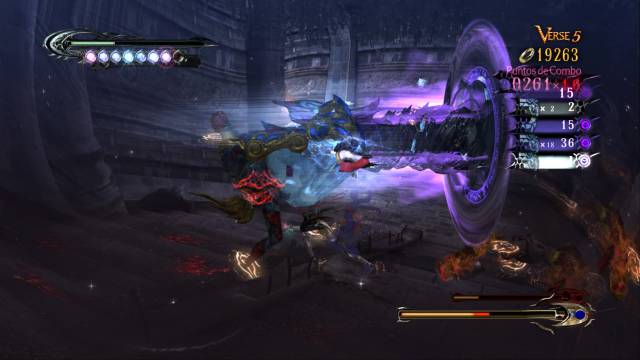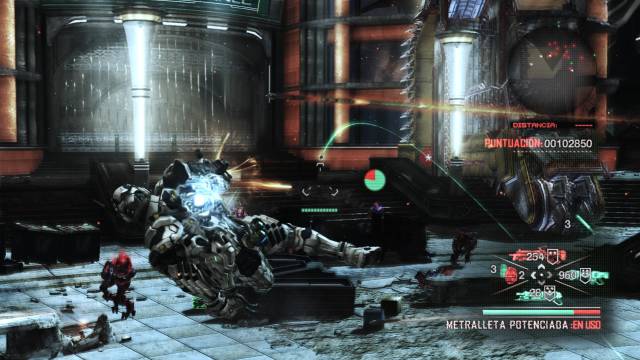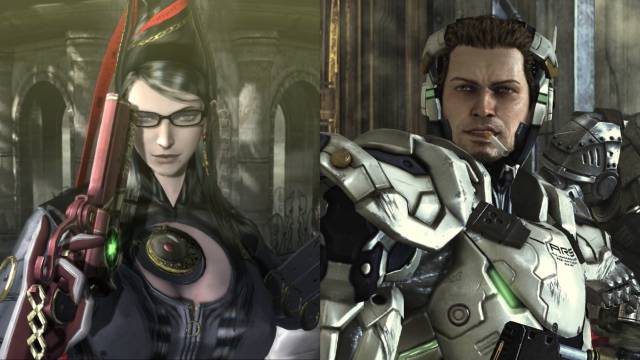
The two Platinum Games classics come to life on PS4 and One. Do they still deserve our attention as much as a decade ago?
The arrival of Bayonetta and Vanquish to current consoles may present an unbeatable opportunity to celebrate a decade of Platinum Games games, but understanding what this double of modern classics means requires a bit more comeback. To another saga and even to another company. Because in the still farther 1996, Capcom launched Resident Evil and changed everything. He changed the face of terror, cementing the bases of Survival Horror, and also changed the careers of Shinji Mikami and Hideki Kamiya. Following this brilliant success, teacher and student remained involved in the saga, directing not long after a remake and a sequel respectively. What interests us, however, is the curious fact that at different points in time, both were commissioned to conceive the fourth installment of the saga, and both used that opportunity to create something radically different. It was, in a way, the spiritual origin of Platinum Games.
Because Kamiya has never hidden that terror is not his forte. Raised between arcade booths, his were the most intense action games, with several layers of depth and margin for the player to express himself through his skill. The camera system, the backtracking and the atmosphere showed the origin of Devil May Cry as an attempt to turn the Survival Horror, but only a couple of minutes fighting served to realize that the final result was cementing a new genre. Mikami, who had supported him in the name change, then inherited his responsibility. And although technically that effort did come out a game called Resident Evil 4, the result rethink the landscape of a different genre. When after two years the two decided to embark on an adventure away from Capcom, the franchises were off the table, but not the formulas: after the founding of Platinum Games it was time to reinvent the reinvent. Give another twist to the Hack and Slash and the Third Person Shooter. And just that they did.
Bayonetta: Witches Don't Cry
Although Bayonetta was not the first Platinum game – that honor falls to the forgotten MadWorld – it is unquestionable that its arrival set the company's overall tone. From Metal Gear Rising to Astral Chain, through its own continuation –which will soon be two–, Bayonetta's influence almost always permeates the style of combat, the rhythm of progression, casual attitude or high replayability, when not everything at once. It may have originally been a declaration of Kamiya's intentions, but now it is a mantra for the study that can even invade licenses that were rooted in different philosophies as in the case of NieR. But what about your stepbrother? To what extent could all this be said about Devil May Cry and, in the process, relativize Bayonetta's achievements? It is a somewhat complicated way of asking ourselves if Bayonetta is the kind of game that ten years later deserves to be (re) bought, or if those elements that it shares with previous and subsequent games have made it lose its validity.
And the answer, without making the partridge more dizzy, is no. Bayonetta remains in the middle of 2020 an excellent Hack and Slash that no fan of the genre – or interested in starting – should miss. For starters, for assuming the origin of the homonymous witch, as representative of the company as Mario de Nintendo – not in vain, now they share a template at Smash Bros. -. Confident and mischievous, she carries on her shoulders the weight of an argument that tends to wander, but always finds in it the anchor that spins mysteries, hyperbolic action and humor. His accentuated sexuality defines interactions with friends and, above all, enemies. It is a suggestive component, sometimes hilarious for reasons that you may like more or less, but also a sign of mastery and ridicule with playable applications. From the hair that alternates between clothing and demonic invocations to executions where we whip angels trapped in instruments of torture, Bayonetta is unmarked from Dante not simply being his female version, but by reversing the cliché of roles and using his sex as a powerful and fun weapon.

Although of course, being a Kamiya game, this sadistic revelry does not remain in simple spectacle. Underneath there is also a deep combat system that we can summarize through the interaction of three basic mechanics, easy to understand, but demanding if we want to survive in high difficulties or get the best medals. The first is the sorcerer time, a brief mode where everything – less Bayonetta – slows down a few seconds if we dodge just before receiving an attack. This facilitates the execution of a wide repertoire of combos that, after chaining a series of commands, culminate in very powerful movements called hex attacks – grips or giant kicks according to the command that closes the combo. The key here is that attacks can be chained in almost any way and, more importantly, sustained over time before moving on to the next one, so memorization does not matter as much as the ability to enter a rhythm that allows keeping combos to reach the hexes and multiply damages and points.
What makes Bayonetta more special if possible is that playing at a superficial level (crushing buttons) these two mechanics can collide: dodging to enter the warlock reboots the combo and cancels the hex attack. There appears the third mechanic, the interruptus combo, which consists of dodging without releasing the attack button and then resuming the same chain and thus culminating it. With practice, the three mechanics intertwine harmoniously and raise a combat as technical as visceral, even among the best in the genre. Because on this later he stacks even more mechanics, such as the presence of a magic bar to execute certain actions, the acquisition of optional techniques in Rodin's store, the mentioned torture attacks, the rotation between different types of weapons or even the possibility of wielding Temporarily some of the enemies. Bayonetta is an ode to the Hack and Slash that masterfully disposes dozens of components and then pushes the player to have fun experimenting as he discovers them and improves their execution.

Vanquish: TPS and Slash
Moving on to Vanquish, the story is a bit different. Released almost a year after Bayonetta, he did not finish achieving his same status and for now he has run out of sequel – something that does not help that Mikami does not continue in Platinum. However, that does not mean that it is also an exceptional game. As we anticipated at the beginning, part of its concept goes back to Resident Evil 4 and its reinvention of the action with a camera on the shoulder, but there are two other influences that cannot be ignored either. The first is, of course, Gears of War, which shortly thereafter proposed its own revolution for the Third Person Shooter genre in the hands of a system of coverage – present only in a timely and contextual way in RE4 – imitated to satiety during its generation. The second, more interesting and relevant for the bundle that concerns us, is Bayonetta himself. Because Vanquish is a TPS, but inherits that vision of "deep arcade" so typical of Kamiya, to the point of blurring the line between genres and function very similar to a Hack and Slash.
In a post-Uncharted 2 and post-Mass Effect 2 world, its warm reception is understandable if taken for its apparent value. With fewer resources than the big companies, an artistic direction almost as in love with the Grays as the first Gears, a raunchy narrative anchored in the manic Americans against Russians – in space! -, and a campaign below eight hours without Multiplayer, it was easy to classify Vanquish as a competent, but derivative, Japanese reinterpretation of the formula. He certainly did not have the situational variety that Resident Evil 4 himself had shown in Mikami hands. The question, although all of this is true, is that the game goes considerably beyond that apparent value. Covering and shooting, like using combos of punches and evasions in Bayonetta, makes the effort to advance in medium or low difficulties. But there is a wealth beyond that, revealed after a bit of mining, which makes Vanquish a serious contender for the throne of the TPS.

To see it better, we can highlight three mechanics that do not even include coverage – although it relates to them. The first is propulsion, a method of displacement that slides at full speed in any direction. This allows us to get closer to the enemies and flee their fire in just seconds, creating a more dynamic battlefield. However, its abuse is paid with overheating, second mechanic regulated by a bar in the interface. And it deserves its own mention because it not only conditions the propulsion, but also the AR mode. Like the sorcerer time, or Max Payne's bullet time, this mechanic slows down the action to aim better, dodge projectiles or detect weak points. The three mechanics are presented and used in the game in its most basic form, but, as in the Hack and Slash, they also create a synergy with each other and with others such as evasive somersaults or attacks – firearms, grenades, melee strikes. – to open the doors to experimentation and advanced game tactics.
Because Vanquish may not have combos per se, but it does allow playing with combinations of mechanics and rhythm changes to dominate the combat zone in an atypical way in a shooter. The irony is that the deeper we go, the more coverage can be trivialized even if we get up and the enemies are more dangerous (the score, in fact, improves the less they are used). For example, proper alternation between sliding and somersaults increases invincibility frames and reduces overheating. And hitting during a slide throws us up to enter AR mode and finish off the work suspended in the air. The scoring system, unfortunately, is not reinforced with clear prizes like Bayonetta, so this kind of personal improvement, in addition to showing off in online rankings, serves more the purpose of surviving in style and optimizing test performance Challenge mode In a beautiful twist of fate, Vanquish is Mikami's “more Kamiya” game, and stands as a 100% Platinum play despite not belonging to its most recurring genre.

Anniversary Bundle: Improvements and other considerations
Focusing on the current ports, now released on PS4 and Xbox One, we are basically facing adaptations of the remastering of 2017 for PC. What comes to say that there is no new content, but a tuning in the form of higher resolution – with the possibility of 4K on PS4 Pro and One X -, stable framerate and reduced load times, with the secondary effect that Bayonetta practice screens and Vanquish informational texts are useless because of how quickly they disappear. Vanquish is the biggest beneficiary, since he used to suffer to keep 30fps at 720p. Of course, there are still certain roughnesses, such as less sharpness and small pulls in the pre-recorded sequences, although luckily they are more the exception than the norm: although closely both show their age in details such as some textures or shadows, they are of by far the best console versions and enjoy the fluidity that the frenzy of their fighting deserved.
Graphics aside, being the same games as a decade ago means that all the virtues exposed are maintained, but also other limitations or questionable decisions of that time. For example, the stellar bout of Bayonetta is sometimes interspersed by potentially frustrating situations, where an unexpected platform section or a badly pressed Quick Time Event involves instant death and hits the punctuation of the chapter – something in which Bayonetta 2 It would moderate. Similarly, although Vanquish focuses more precisely on his strengths, perhaps he does too much: the variety outside the situations created organically in combat does not have the same recreational value of other TPS, surely due to not counting Nor with comparable resources. In what is good, it is very good. We could say the best. But if it has not been played before and this relaunch is reached from scratch, it is something to consider.

CONCLUSION
Bayonetta and Vanquish tell the story of a young and modest developer, but already with very clear ideas in their origins. Rescue them a decade later, after a whole generation and seen great titles both inside and outside their genres could play against this late comeback. It could, but it is not the case. Bayonetta is still rubbing shoulders with Hack and Slash the size of his sequel or Devil May Cry 5. And Vanquish … Well, there really isn't anything exactly like Vanquish. In the graphic aspect they are not going to surprise anyone – beyond the intrinsic spectacle to their proposals – and they also do not bring novelties outside the best performance. But that is why, for sticking a nostalgic trip, or for paying outstanding bills, it is difficult not to recommend them as soon as they are interested in the challenges posed by Kamiya and Mikami. Both perfectly encapsulate the Platinum spirit, one of the best action studies not for its resources or narrative claims, but for its love towards the game as an experience built from its mechanics.
THE BEST
- Two Platinum Games classics, together and remastered.
- Demanding and deep fighting. They improve in sandwiches.
- Even with humble resources, the staging of both is spectacular.
WORST
- Expected, but no new content.
- Some technical inconsistency in the presentation.
Very good
Remarkable game that we will enjoy and remember. A good purchase, highly recommended for lovers of the genre. It is well taken care of at all levels.
